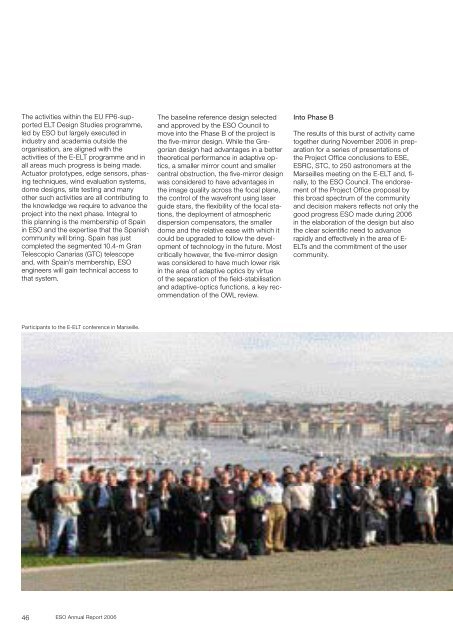Untitled - ESO
Untitled - ESO
Untitled - ESO
Create successful ePaper yourself
Turn your PDF publications into a flip-book with our unique Google optimized e-Paper software.
The activities within the EU FP6-supported<br />
ELT Design Studies programme,<br />
led by <strong>ESO</strong> but largely executed in<br />
industry and academia outside the<br />
organisation, are aligned with the<br />
activities of the E-ELT programme and in<br />
all areas much progress is being made.<br />
Actuator prototypes, edge sensors, phasing<br />
techniques, wind evaluation systems,<br />
dome designs, site testing and many<br />
other such activities are all contributing to<br />
the knowledge we require to advance the<br />
project into the next phase. Integral to<br />
this planning is the membership of Spain<br />
in <strong>ESO</strong> and the expertise that the Spanish<br />
community will bring. Spain has just<br />
completed the segmented 10.4-m Gran<br />
Telescopio Canarias (GTC) telescope<br />
and, with Spain’s membership, <strong>ESO</strong><br />
engineers will gain technical access to<br />
that system.<br />
Participants to the E-ELT conference in Marseille.<br />
46<br />
<strong>ESO</strong> Annual Report 006<br />
The baseline reference design selected<br />
and approved by the <strong>ESO</strong> Council to<br />
move into the Phase B of the project is<br />
the five-mirror design. While the Gregorian<br />
design had advantages in a better<br />
theoretical performance in adaptive optics,<br />
a smaller mirror count and smaller<br />
central obstruction, the five-mirror design<br />
was considered to have advantages in<br />
the image quality across the focal plane,<br />
the control of the wavefront using laser<br />
guide stars, the flexibility of the focal stations,<br />
the deployment of atmospheric<br />
dispersion compensators, the smaller<br />
dome and the relative ease with which it<br />
could be upgraded to follow the development<br />
of technology in the future. Most<br />
critically however, the five-mirror design<br />
was considered to have much lower risk<br />
in the area of adaptive optics by virtue<br />
of the separation of the field-stabilisation<br />
and adaptive-optics functions, a key recommendation<br />
of the OWL review.<br />
Into Phase B<br />
The results of this burst of activity came<br />
together during November 006 in preparation<br />
for a series of presentations of<br />
the Project Office conclusions to ESE,<br />
ESRC, STC, to 50 astronomers at the<br />
Marseilles meeting on the E-ELT and, finally,<br />
to the <strong>ESO</strong> Council. The endorsement<br />
of the Project Office proposal by<br />
this broad spectrum of the community<br />
and decision makers reflects not only the<br />
good progress <strong>ESO</strong> made during 006<br />
in the elaboration of the design but also<br />
the clear scientific need to advance<br />
rapidly and effectively in the area of E-<br />
ELTs and the commitment of the user<br />
community.

















